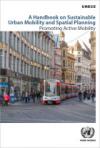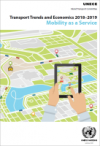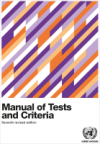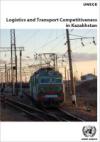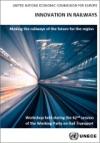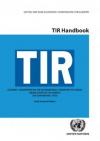Publications
Displaying Results 41 - 60 of 227
- Français
L’ADR, fait à Genève le 30 septembre 1957 sous l'égide de la Commission économique des Nations Unies pour l'Europe, est entré en vigueur le 29 janvier 1968.
Cet Accord est destiné à accroître la sécurité du transport international de marchandises dangereuses par route. Ses annexes A et B imposent les conditions dans lesquelles les marchandises dangereuses, lorsqu'elles ne sont pas interdites,
- English
Adopted on 30 September 1957 in Geneva under the auspices of the United Nations Economic Commission for Europe (UNECE), the ADR entered into force on 29 January 1968.
This authoritative Agreement is intended to increase the safety of international transport of dangerous goods by road. Its Annexes A and B contain the technical requirements for road transport, i.e. the conditions under which
- Pусский
В 2002 году государства-члены Европейского региона ЕЭК и ВОЗ разработали Общеевропейскую программу по транспорту, окружающей среде и охране здоровья (ОПТОСОЗ). ОПТОСОЗ обеспечивает межсекторальные и межправительственные политические механизмы, что способствует развитию мобильности и транспортных стратегий, которые учитывают проблемы окружающей среды и здоровья. За все эти годы в рамках ОПТОСОЗ
- English
Member States in the ECE and WHO European Region established the Transport,Health and Environment Pan European Programme (THE PEP) in 2002. By providing an intersectoral and intergovernmental policy framework, THE PEP promotes mobility and transport strategies that integrate environmental and health concerns. Over the years, THE PEP has led to the development of implementation mechanisms to
- English
As part of the ongoing work on THE PEP a Study on good practices in Mobility Management has been published.Drawing on concrete experiences from across the Pan-European region, the guide, developed under the Transport Health and Environment Pan-European Programme (THE PEP), provides practical policy considerations enriched by a total of 22 good practices from 17 countries that set out the
- English
ECE/TRANS/290,
Sales No. E.20.VIII.2,
ISBN 978-92-1-117241-6,
Price: US$ 35,
Languages: E, F, R
The Agreement on the International Carriage of Perishable Foodstuffs and on the Special Equipment to be Used for such Carriage (ATP) was done at Geneva on 1 September 1970 and entered into force on 21 November 1976.
The objectives of the ATP are to facilitate international transport
- English
The Contracting Parties to the TIR Convention launched in 2003 the so-called “eTIR Project”, aimed at providing an exchange platform for all actors (Customs authorities, holders and guarantee chains) involved in the TIR system, known as the “eTIR international system” (Customs to Customs).The eTIR international system aims to ensure the secure exchange of data between national Customs systems
- English
Mobility as a Service (MaaS) is a new mobility concept gaining pace in many cities around the world. Its value proposition concerns integration of mobility services which is realized by providing trip planning and one-stop fare purchase for the user through a single platform.Since MaaS is only emerging, the analysis of real-life demonstrations is still limited and, thus, evidence on the
- English
Regional maps available here
Extreme weather events, some of which are increasing in intensity and frequency, as well as slower onset climate changes (for example, sea level rise) and cumulative effects can result in transportation infrastructure damages, operational disruptions, and
- English
As part of the ongoing activities of the Working Party on Rail Transport (SC.2) a workshop titled “Making rail freight more competitive: The coordinated development of the rail network with a focus on how to work together at the government and sectoral levels on the EATL” was held at the seventy-third session of the Working Party.Over 60 participants from national administrations,
- English
A study on the transport infrastructure and services available in Kyrgyzstan. This document reviews the country’s extensive recent and future transport investments, and sets out recommendations to ensure its transport network is ready to harness the growth in inland transport from rising Asia-Europe trade, particularly in the context of the Belt and Road Initiative.
- English
ST/SG/AC.10/11/Rev.7
Sales No. E.20.VIII.1
ISBN 978-92-1-130394-0
eISBN 978-92-1-004503-2
Languages: E, F, (A, C, R, S forthcoming)
How to order this publication?
This publication is also available online for free (download).
The "Manual of Tests and Criteria" contains criteria, test methods and
- English
These recommendations have been developed in the light of technical progress, the advent of new substances and materials, the exigencies of modern transport systems and, above all, the requirement to ensure the safety of people, property and the environment. They are addressed to governments and international organisations concerned with the regulation of the transport of dangerous goods. The
- English
The GHS addresses classification of chemicals by types of hazard and proposes harmonized hazard communication elements, including labels and safety data sheets. It aims at ensuring that information on physical hazards and toxicity from chemicals be available in order to enhance the protection of human health and the environment during the handling, transport and use of these chemicals.
The GHS
- English
Improving the competitiveness of Kazakhstan as a transport logistics centre at the crossroads of Europe and Asia could enable the country to unlock significant untapped benefits of growing cargo flows between the two continents. This study identifies the transport infrastructure and services available in Kazakhstan, reviews the country’s extensive recent and future transport investments,
- English
As part of the ongoing activities of the Working Party on Rail Transport (SC.2) a workshop titled “Making the railways of the future for the region” was held at the seventy-second session of the Working Party.Over 65 participants from national administrations, international organizations, non-governmental organizations and the private sector discussed, over a number of sessions, the role of
- English
The European Agreement concerning the International Carriage of Dangerous Goods by Inland Waterways (ADN) done at Geneva on 26 May 2000 under the auspices of the United Nations Economic Commission for Europe (UNECE) and the Central Commission for Navigation on the Rhine (CCNR) has been in force since February 2008. The Agreement currently has eighteen Contracting Parties. The Regulations
- English
Adopted on 30 September 1957 in Geneva under the auspices of the United Nations Economic Commission for Europe (UNECE), the ADR entered into force on 29 January 1968. This authoritative Agreement is intended to increase the safety of international transport of dangerous goods by road. Its Annexes A and B contain the technical requirements for road transport, i.e. the conditions under



